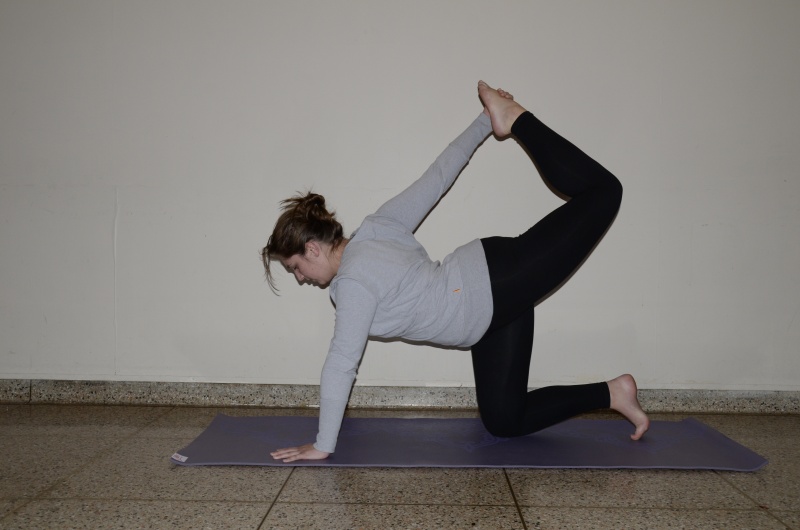Fordham’s Whitewashing of Yoga Practices and Its Roots
Ignatian Spirituality and Yoga attempts to blend Ignatian and Hindu spirituality but the latter falls short
LUCIA PUERTAS VIA FLICKR
Like all sacred rituals, yoga should be performed without the erasure of its rich culture, spirituality, and history.
April 26, 2022
I was walking the halls of the Lincoln Center campus during New Student Orientation this past fall when it became clear to me that this school is a Jesuit institution. It’s no secret that Fordham stands by Ignatian philosophies and ideals like “cura personalis,” or “care for the whole person,” as we’ve all heard seemingly unendingly since we’ve started school here.
I thought that this motto would mean that I was joining a school that not only provided academic but personal care for its students. Through all of this, I never considered the possibility that the presence of this Ignatian groundwork would contribute to the whitewashing of other students’ religious and spiritual groups on campus.
Fordham is affiliated with Ignatian Spirituality and Yoga, an organization that results in the whitewashing of Hinduism through the practice of yoga on campus.
This isn’t a new organization, and it isn’t exclusive to Fordham either. According to its official website, Ignatian Spirituality and Yoga — which was founded in July 2016 — was established by the Midwest Province of the Society of Jesus. Its main mission was to establish “a collaborative ministry led by Jesuits and laypeople formed in both the Ignatian and yoga traditions.”
When there is an attempt to practice yoga without specifically educating oneself about these origins and practices it erases the culture ingrained in the practice.
But it seems, at least in my observations, that they rarely attempt to be inclusive and adapt Dharmic, specifically Hindu, traditions and spirituality within their practices. If their goal has always been to successfully blend and explore both cultures’ practices, then they would dedicate, at minimum, a significant amount of their time referring to Hinduism, Buddhism, Jainism, Indian spirituality and the history of yoga.
Historically speaking, yoga is derived from the Indian subcontinent and has spiritual and religious roots in Vedic texts and practices. When there is an attempt to practice yoga without specifically educating oneself about these origins and practices it erases the culture ingrained in the practice — thereby, whitewashing it.
Carol Gibney, the associate director of Campus Ministry for Spiritual & Pastoral Ministries, told me about her role as a certified yoga teacher and the Ignatian Spirituality and Yoga sessions she hosts on both Fordham campuses. She stressed the idea of students in Fordham needing to “slow down” and “pray with their bodies.”
Throughout our conversation, she spoke about how institutions of higher education can often force students to stay busy all the time and get “stuck in their heads.” She wanted to use her experience with yoga to help students get back in touch with themselves and their spirituality.
While this sentiment is important within the context of mental health for students, by Fordham not making it a priority for these instructors to begin to teach and incorporate Hindu spirituality are doing a disservice to students by disseminating a whitewashed version of yoga.
Gibney said she incorporates Hindu philosophy “respectfully” but tries to “not talk a lot during the sessions, (and) just invite(s) people to offer this time as a time to pray with their body.”
Placing yoga under an Ignatian label and not putting in enough of an effort to acknowledge and incorporate Hindu philosophy while practicing it is an extremely harmful thing to do.
Placing yoga under an Ignatian label and not putting in enough of an effort to acknowledge and incorporate Hindu philosophy while practicing it is an extremely harmful thing to do, as it neglects the roots and communities that have developed this sacred practice into what it is today.
Ramesh Rao, chair of the center for communications studies and theatre at Longwood University and a human rights coordinator for the Hindu American Foundation, explains in an op-ed from The Guardian that yoga has become more and more culturally relevant and profitable in the West, but “few yoga teachers and journals mentioned the origins of the practice and its connection to Hinduism.”
Some studies place the current value of the yoga industry (yes, it’s an industry) at around $84 billion. Yet, most of the money made capitalizing off of this practice is much more likely to end up in the pockets of a white person than the poor garment workers of India, who made the yoga pants and from whom this practice was originally stolen.
These small steps are not nearly enough of an acknowledgment of the true roots of yoga.
Furthermore, yoga has become secularized over the past decade in the West “to rid it of any taint of a ‘pagan’ tradition.” Yoga, as a practice, has been commodified and capitalized upon by mostly white people. It isn’t right to strip this ancient Dharmic practice of its true origin and place it under the label of Ignatian spirituality without doing anything to acknowledge its Hindu roots.
Madisen Caferro, Fordham College at Rose Hill ’23, who has frequented Ignatian Spirituality and Yoga sessions since her first year at Fordham, stated that the use of the word “namaste” at the end of each lesson is the extent to which Hinduism and Indian spirituality is acknowledged during these sessions, as well as the yoga poses that retain their original Sanskrit names.
These small steps are not nearly enough of an acknowledgment of the true roots of yoga, especially not enough to claim that you are practicing yoga respectfully.
There are many steps that the Ignatian Spirituality and Yoga community on campus can take to become more inclusive and begin to incorporate fewer whitewashed teachings throughout their sessions. Beyond using phrases such as “namaste” and the correct Sanskrit phrases and names for all of the asanas (yoga poses), learning yoga also has to include a discussion of the religious and spiritual teachings behind it, as well as learning the asanas.
Susanna Barkataki discusses this phenomenon in her blog post, “How to Decolonize Your Yoga Practice,” in which she states that if someone from the West becomes a certified yoga teacher and carries out classes that are mainly asana-based (pose-based), they end up remaining “blissfully unaware of the complexity of yoga’s true aim or the roots of the practices” and are “culturally appropriating yoga.”
Barkataki believes that when we continue to practice yoga and remain ignorant to its history and religious roots — as well as the discrimination that its authentic practice has faced in the Christian, white, Western world — we run the risk of perpetuating a recolonization of yoga by “stripping its essence away.”
It’s important that we acknowledge how heavily appropriated yoga has become by white people. I hope that going forward, we all at Fordham — myself included — learn to be more accepting and embrace the process of learning about cultural appropriation and decolonizing our own practices, rather than coming from a place of defensiveness.














